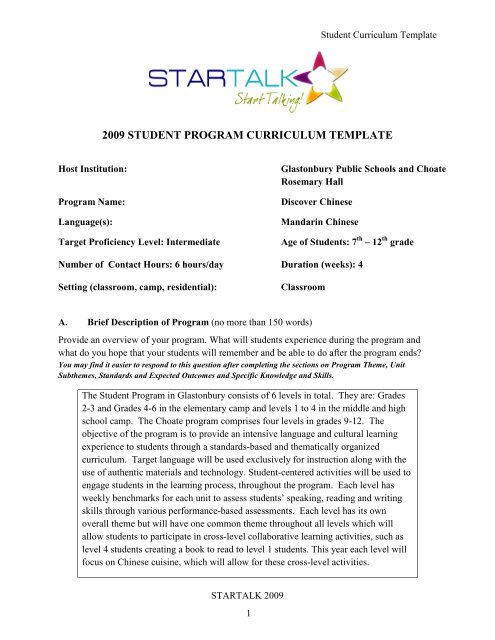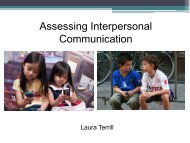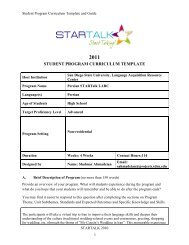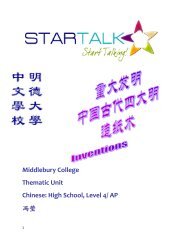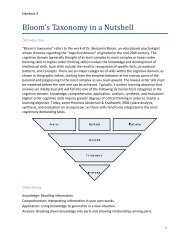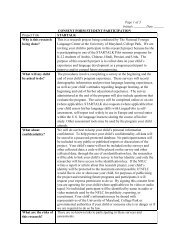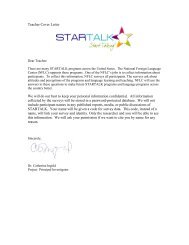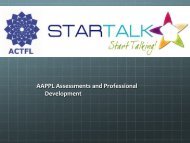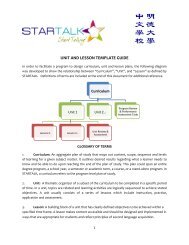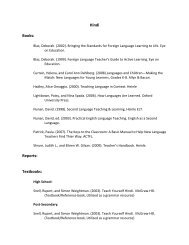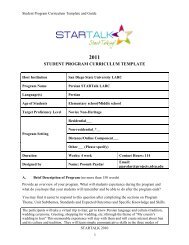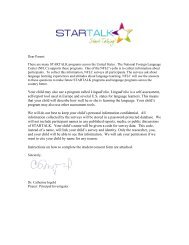ACTFL Student Curriculum Level 3 068.1 - StarTalk
ACTFL Student Curriculum Level 3 068.1 - StarTalk
ACTFL Student Curriculum Level 3 068.1 - StarTalk
Create successful ePaper yourself
Turn your PDF publications into a flip-book with our unique Google optimized e-Paper software.
<strong>Student</strong> <strong>Curriculum</strong> Template2009 STUDENT PROGRAM CURRICULUM TEMPLATEHost Institution:Program Name:Language(s):Target Proficiency <strong>Level</strong>: IntermediateGlastonbury Public Schools and ChoateRosemary HallDiscover ChineseMandarin ChineseAge of <strong>Student</strong>s: 7 th – 12 th gradeNumber of Contact Hours: 6 hours/day Duration (weeks): 4Setting (classroom, camp, residential):ClassroomA. Brief Description of Program (no more than 150 words)Provide an overview of your program. What will students experience during the program andwhat do you hope that your students will remember and be able to do after the program ends?You may find it easier to respond to this question after completing the sections on Program Theme, UnitSubthemes, Standards and Expected Outcomes and Specific Knowledge and Skills.The <strong>Student</strong> Program in Glastonbury consists of 6 levels in total. They are: Grades2-3 and Grades 4-6 in the elementary camp and levels 1 to 4 in the middle and highschool camp. The Choate program comprises four levels in grades 9-12. Theobjective of the program is to provide an intensive language and cultural learningexperience to students through a standards-based and thematically organizedcurriculum. Target language will be used exclusively for instruction along with theuse of authentic materials and technology. <strong>Student</strong>-centered activities will be used toengage students in the learning process, throughout the program. Each level hasweekly benchmarks for each unit to assess students’ speaking, reading and writingskills through various performance-based assessments. Each level has its ownoverall theme but will have one common theme throughout all levels which willallow students to participate in cross-level collaborative learning activities, such aslevel 4 students creating a book to read to level 1 students. This year each level willfocus on Chinese cuisine, which will allow for these cross-level activities.STARTALK 20091
<strong>Student</strong> <strong>Curriculum</strong> TemplateCommunication - InterpersonalCommunication - PresentationalCultural Practices/Products/PerspectivesConnectionsComparisons- introduce themselves to others andfind out about the other person- interact with someone discussingChinese food- find out from others their opinion ofChinese cuisine- present and promote their travellocation by making a travel brochureon the regional differences in cuisine- design and present a travel itineraryaccording to the assigned scenario- make a Chinese dish at home- participate in a on-site cooking contest- debate on food issues- play Mahjong, do Chinese dance,kung fu, Tai-chi,- visit an Asian supermarket and findthe Chinese ingredients needed for adish- visit an authentic Chinese restaurantand order dishes- visit New York’s Chinatown andpractice their bargaining skills- discuss their own experiences visitingChina, Chinatowns, Chineserestaurants, or Chinese friends- find out more details about the citytheir parents are from (if they areChinese) or their friends’ families arefrom- discuss their authentic Chinese diningexperience and determine whichtradition of Chinese cuisine isrepresented in their dish- compare the similarities anddifferences between English andChinese- compare the differences betweennorthern and southern China- compare the differences betweentraveling to China and to AmericaSTARTALK 20093
<strong>Student</strong> <strong>Curriculum</strong> TemplateCommunity- Compare and contrast the mostcommon ingredients between Chineseand American cooking- compare the characteristics of theeight traditions of Chinese cooking- Compare the differences betweenAmerican supermarkets and Asiansupermarkets- Shop at an Asian supermarket- Order Chinese food in an authenticChinese restaurant- visit New York’s Chinatown and getthe first-hand experience in theChinese communitySTARTALK 20094
E. Specific Knowledge and Skills<strong>Student</strong> <strong>Curriculum</strong> TemplateWhat specific linguistic, cultural, and other subject matter knowledge and skills will students belearning as they work with this theme? (e.g., language functions, cultural knowledge/ practices/perspectives, knowledge related to subject matter or concepts.) Identify what students will do interms of, but not limited to, LinguaFolio-like Can Do statements that are aligned with theStandards for Foreign Language Learning in the 21 st Century.Thematic Knowledge and Skills<strong>Student</strong>s Can<strong>Student</strong>s Use♦ identify the geographical♦ Social studies/Geographycharacteristics of Chinaknowledge♦ make presentations using♦ Chinese reading skillscomputer software♦ Language functions♦ read and understand Chinese ♦ Cultural knowledgearticles from textbooks andauthentic materials♦ discuss the eight traditions ofChinese cuisineF. End of Program Performance TasksWhat culminating performance tasks will provide evidence that students have achievedthe program learning objectives? Indicate how students will be assessed for each modeof communication through interpretive, interpersonal and presentational performancetasks.• Interpretive tasks involve students in receptive communication of oral or writtenmessages, in mediated communication via print and non-print material, or withlistener, viewer, reader works with visual or recorded materials whose creator isabsent.• Interpersonal tasks require direct oral communication between individuals who arein personal contact or direct written communication between individuals who comeinto personal contact.• Presentational tasks require students to engage in productive communication usingoral or written language, produce spoken or written communication for people withwhom there is no immediate personal contact or which takes place in a one-to-manymode, or author or create visual or recorded material for listeners or readers notpersonally known.STARTALK 20095
<strong>Student</strong> <strong>Curriculum</strong> TemplateInterpretive tasks: informal assessment in class and the computer lab, Chinese dish cooking,projects. For example, students will listen to a recipe and will use the information to fill in theinformation on their sheet. <strong>Student</strong>s will also read authentic material and answer questions.Interpersonal tasks: self-introduction, class discussion, pair conversation, daily diary entrywritten to a classmate (who will respond), recipe writing with a partner, Chinese restaurantmenu makingPresentational tasks: travel brochure focusing on regional differences in cuisine , travelitinerary, Chinese cooking at home, Chinese cooking contest on-siteSTARTALK 20096
G. Other Types of Assessment and Evidence of Learning<strong>Student</strong> <strong>Curriculum</strong> TemplateOther types of assessment and evidence of learning may include a wide range of activities andproducts that provide meaningful evidence of learning, such as dialogue journals, reflectivejournals, posters, LinguaFolio self-assessment, role plays, presentations of visual or performancearts, portfolios, audio portfolios, e-portfolios, research projects, or videos. Include someassessment or reflection about students’ attitudes and perspectives toward the target languageand culture.Examples- dialogue- journal entry- travel brochure- 10-day trip itinerary- Make a Chinese dish- debateBrief description- students will work with one or morepartner(s) to make dialogues- students will write a short journal entryeach day- students will each pick a unique city andmake a travel brochure- students will make a complete travelitinerary according to the scenario- each student will read a recipe and makea Chinese dish at home- students will debate about the eighttraditions of Chinese cuisineH. Instructional StrategiesHow will your program ensure that the following best practices are incorporated into yourprogram?StrategiesExamplesUse target language for instruction - encourage a target-language-onlyenvironment (instructions,classroom decorations, resources)- encourage students to expressthemselves in target languageFacilitate student-centered learning - students will choose or be assignedindividual or group tasks and willpresent the tasks to the classEnsure meaningful interaction in thetarget language- make sure the instruction is onlyslightly challenging to the studentsby reviewing and asking relatedquestionsIntegrate language, culture and content - use target language in the real-lifeSTARTALK 20097
<strong>Student</strong> <strong>Curriculum</strong> TemplateDifferentiate instruction based onstudent needcontext, not a textbook one- compare and contrast topics inChina to the students’ ownbackground knowledge- alter lesson plans according tostudents’ reaction to increase ordecrease the level of challenge- provide more challenging andhigher thinking task for advancedstudents- <strong>Student</strong>s will have informationpresented in a variety of wayspresentationsusing PowerPoint,readings, listening activities.<strong>Student</strong>s will also create differentproducts – food for example, whichwill be done in Chinese.I. Materials & Other ResourcesDescribe the primary resources that you plan to use for the program.ResourcesTitle of textbook, ifapplicableRealia / AuthenticmaterialsMultimediaDescriptionChinese Made Easy volume 4♦ Map of China♦ Chinese newspaper travel advertisementand related articles♦ Real Chinese restaurant menu♦ Chinese cookbookComputer, DVD player, projectorSTARTALK 20098
<strong>Student</strong> <strong>Curriculum</strong> TemplateFor Your ReferenceStandards for Foreign Language Learning in the 21 st CenturyGoal 1: CommunicationStandard 1.1- Interpersonal Communication: <strong>Student</strong>s engage in conversation, provideand obtain information, express feeling and emotion, and exchange opinions.Standard 1.2 – Interpretive Communication: <strong>Student</strong>s understand and interpret writtenand spoken language on a variety of topics.Standard 1.3 – Presentational Communication: <strong>Student</strong>s present information, conceptsand ideas to an audience of listeners or readers on a variety or topics.Goal 2: CulturesStandard 2.1 – Practices and Perspective: <strong>Student</strong>s demonstrate an understanding of therelationship between the practices and perspectives of the culture studied.Standard 2.2 – Products and Perspectives: <strong>Student</strong>s demonstrate an understanding ofthe relationship between the products and perspectives of the culture studied.Goal 3: ConnectionsStandard 3.1 – Knowledge of Other Disciplines: <strong>Student</strong>s reinforce and further theirknowledge of other disciplines through the foreign language.Standard 3.2 – Distinctive Viewpoints: <strong>Student</strong>s acquire information and recognize thedistinctive viewpoints that are only available through the foreign language and itscultures.Goal 4: ComparisonsStandard 4.1 – Nature of Language: <strong>Student</strong>s demonstrate understanding of the natureof language through comparisons of the language studied and their own.Standard 4.2 – Culture: <strong>Student</strong>s demonstrate understanding of the concept of culturethrough comparisons of the cultures studied and their own.Goal 5: CommunityStandard 5.1 – Beyond the School Setting: <strong>Student</strong>s use the language both within andbeyond the school setting.Standard 5.2 – Life-long Learners: <strong>Student</strong>s show evidence of becoming life-longlearners by using the language for personal enjoyment and enrichment.STARTALK 200910
<strong>Student</strong> <strong>Curriculum</strong> TemplateCommunicative ModesInterpersonal ModeThe Interpersonal Mode is characterized by active negotiation of meaning among individuals.Participants observe and monitor one another to see how their meaning and intentions are beingcommunicated. Adjustments and clarifications can be made accordingly. As a result, there is ahigher probability of ultimately achieving the goal of successful communication in this modethan in the other two modes. The Interpersonal Mode is most obvious in conversation, but boththe interpersonal and negotiated dimensions can be realized through reading and writing, such asthe exchange of personal letters or electronic mail messages.Interpretive ModeThe Interpretive Mode is focused on the appropriate cultural interpretation of meanings thatoccur in written and spoken form where there is no recourse to the active negotiation of meaningwith the writer or the speaker. Such instances of “one-way” reading or listening include thecultural interpretation of texts, oral or written, must be distinguished from the notion of readingand listening “comprehension,” where the term could refer to understanding a text with anAmerican mindset. Put another way, interpretation differs from comprehension in that theformer implies the ability to “read (or listen) between the lines.”Since the Interpretive Mode does not allow for active negotiation between the reader and thewriter or the listener and the speaker, it requires a much more profound knowledge of culturefrom the outset. The more one knows about the other language and culture, the greater thechances of creating the appropriate cultural interpretations of a written or spoken text. It must benoted, however, that cultural literacy and the ability to read or listen between the lines aredeveloped over time and through exposure to the language and culture.Presentational ModeThe Presentational Mode refers to the creation of messages in a manner that facilitiesinterpretation by members of the other culture where no direct opportunity for active negotiationof meaning between members of the two cultures exists. Examples of the “one-way” writing andspeaking require a substantial knowledge of language and culture from the outset, since the goalis to make sure that members of the other culture, the audience, will be successful in reading andlistening between the lines.______________________National Standards in Foreign Language Education Project (2006). Standards for foreignlanguage learning in the 21 st century. Lawrence, KS: Allen Press, Inc. pp. 36-38.STARTALK 200911


